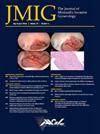美国食品和药物管理局数据库二次分析:手术宫腔镜器械不良事件报告的差异。
IF 3.3
2区 医学
Q1 OBSTETRICS & GYNECOLOGY
引用次数: 0
摘要
研究目的:调查、描述和比较常用手术宫腔镜设备的不良事件报告(AERs)及其模式。设计:对食品和药物管理局发布的制造商和用户设施设备体验(MAUDE)进行二次分析。环境:无患者或参与者:接受宫腔镜手术并向MAUDE报告不良事件的妇女。干预:MAUDE数据库中的搜索词包括“切除镜”、“宫腔镜往复式粉碎器”、“MyoSure”和“TruClear”。报告按器械类型、患者并发症和所需干预措施进行分类。统计分析采用费雪精确检验。测量结果和主要结果:2014年1月至2024年4月,宫腔镜共发现1872例AERs,其中切除术664例,碎裂装置1208例(MyoSure, N=645, TruClear, N=563)。虽然不能从MAUDE计算绝对并发症发生率,但在报告患者并发症方面存在显著差异:切除镜装置的感染频率更高(p)。虽然MAUDE数据库中的结论是有限的,特别是考虑到缺乏关于每种器械的手术量和自愿报告机制的数据,但在手术宫腔镜器械中报告的不良事件类型存在显着差异。与切除术的AERs相比,分块AERs的患者并发症发生率明显更高,并且描述了更多的手术干预措施。当比较MyoSure和TruClear时,MyoSure AERs描述的严重患者并发症比例明显高于TruClear装置AERs。具有类似功能的设备可能在利益相关者报告并发症的方式上有所不同。本文章由计算机程序翻译,如有差异,请以英文原文为准。
Food and Drug Administration Database Secondary Analysis: Difference in Operative Hysteroscopy Device Adverse Event Reporting
Study Objective
To investigate, describe, and compare adverse event reports (AERs) and their patterns amongst commonly used operative hysteroscopy devices.
Design
A secondary analysis of the Manufacturer and User Facility Device Experience (MAUDE) published by the Food and Drug Administration.
Setting
N/A.
Patients or Participants
Women who underwent hysteroscopic surgery, with adverse events reported to MAUDE.
Interventions
Search terms within the MAUDE database included “resectoscope,” “hysteroscopic reciprocating morcellator,” “MyoSure,” and “TruClear.” Reports were categorized by device type, patient complications, and required interventions. Statistical analysis utilized Fisher’s exact tests.
Measurements and Main Results
Between January 2014 and April 2024, 1872 AERs were identified for hysteroscopes: 664 for resectoscopes and 1208 for morcellation devices (MyoSure, N = 645 and TruClear, N = 563). While absolute complication rates are not able to calculated from MAUDE, there were significant differences in the reporting of patient complications: resectoscope devices had higher frequency of infection (p < .01) while morcellation devices had higher frequency reporting of hemorrhage (p < .001), uterine perforation (p < .001), and bowel perforation (p < .001). Morcellation device AERs more often reported operative intervention (1.1% vs 12.4%, p < .001). Subgroup analysis comparing AERs of morcellation devices showed the majority (73.2%) of TruClear AERs registered no patient impact or harm, while only 21.2% of MyoSure AERs reported no patient impact. MyoSure device AERs had higher frequency of hemorrhage (p < .001), infections (p < .001), uterine perforations (p < .001), and bowel perforations (p < .001). Additionally, MyoSure AERs reported more surgical intervention compared to TruClear AEs (19.5% vs 4.3%, p < .001).
Conclusion
While conclusions within the MAUDE database are limited, especially given the lack of data concerning the volume of surgeries done with each device and the voluntary reporting mechanism, there are significant differences in the types of adverse events reported among operative hysteroscopy instruments. Morcellation AERs had a significantly higher frequency of patient complications and described more surgical interventions compared to AERs for resectoscopes. When comparing MyoSure and TruClear, MyoSure AERs described a significantly greater proportion of serious patient complications compared to TruClear device AERs. Devices with similar functions may differ in how stakeholders report complications.
求助全文
通过发布文献求助,成功后即可免费获取论文全文。
去求助
来源期刊
CiteScore
5.00
自引率
7.30%
发文量
272
审稿时长
37 days
期刊介绍:
The Journal of Minimally Invasive Gynecology, formerly titled The Journal of the American Association of Gynecologic Laparoscopists, is an international clinical forum for the exchange and dissemination of ideas, findings and techniques relevant to gynecologic endoscopy and other minimally invasive procedures. The Journal, which presents research, clinical opinions and case reports from the brightest minds in gynecologic surgery, is an authoritative source informing practicing physicians of the latest, cutting-edge developments occurring in this emerging field.

 求助内容:
求助内容: 应助结果提醒方式:
应助结果提醒方式:


